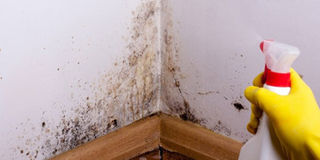Ways to rid your home of mould

Used with vinegar and water or alone with water, baking soda is effective at removing mould naturally. Dissolve baking soda into water or water-and-vinegar solution, and spray onto surface. Let it sit, then scrub and wipe with a damp cloth. NET Photos
What you need to know:
- Mould is a type of fungus that naturally grow in many places, but inside your house it can pose a health risk and negatively impact air quality. Therefore, preventing mould in your house is important for health and safety of your family and visitors.
Mould grows on organic materials such as paper, leather, dirt and soap scum. They grow best at warm, moist temperatures, between 72 to 81 degrees Fahrenheit (22 to 27 degrees Celsius).
The simplest way to detect a mould problem is using your own senses. A musty odour is one indication. Not only is mould smelly, but it can be many different colours from black and gray to orange and green. Watermarks on the ceiling and walls are also a tell-tale sign.
Most often bleach and water can be used to rid the house of mould. The problem is this does not guarantee that the mould will not come back and the only way to keep your house clean is to prevent it from occurring.
Walls
Rashid Senyonjo, an engineer with HIL-Consult, says mould can grow in places such as the ceiling, bathroom, kitchen and under carpets. He says where one chooses to build a house is a determinant factor.
For example, if one builds in a swampy area with high humidity, moisture will penetrate the walls of the house.
“This might not be noticed in a single day but with time one will start observing cracked or peeling paint which are some of the early signs of moisture presence,’’ he explains, adding that one should also take extra care of their home’s plumbing to avoid leakages. If a leakage is caught early and fixed, he says, then mould will also be controlled.
Ceiling
Senyonjo says ceilings made out of porous materials such as wood are likely to attract mould especially when the roof of the house develops a leakage. Small patches of mould will start appearing under the ceiling which is a sign that there is a large colony of mould on the inside of the ceiling.
Floor
David Mawanda of Sawa Construction Company in Kyengera, says mould will normally appear in form of white patches that grow beneath the floor, which is caused by high humidity under the floor rising from the foundation of the house especially if the house was built in a water logged area.
He adds that this can be made worse when one opts for a carpet since these trap moisture.
“Carpets take long to dry which means they can easily foster mould growth. Be careful not to spill liquids on the carpets and if this happens, ensure it dries thoroughly before returning it to the house,” he advises.
Kitchen
Doreen Azaninka, an interior designer with Azan interiors in Kampala, says since there is continuous flow of water in addition to things such as unwashed dishes in the kitchen, mould is likely to favour this place in the house.
“To keep moisture at bay in the kitchen, throw rotten foods away and ensure that leftovers are properly disposed of preferably outside the house. Also ensure that there are no water leakages under your kitchen sink. This place should always be kept dry,” she advises.
How to prevent mould
Mawanda says surfaces such as sinks or floors are favourite places for mould especially if they are wet most of the time. Since most of these are non-porous (tile, stone, laminate), they can easily be cleaned with disinfectants and other cleaners. “Once you have finished cleaning, make sure no moisture remains,” he advises.
Mawanda adds that you should get a professional plumber to inspect the drainage system and fix leaking pipes, taps or shower heads.
“A good ventilation system of a house is one way to keep humidity low in the house and by controlling moisture, mould will be out of sight,” he adds.
Senyonjo says you should open windows during the day, especially when it is hot because this is when humidity is usually at its lowest point outside and remembering to close the windows when it is raining outside to keep the inside warm.
“For self-contained houses, ventilation must be given the first priority during construction. For example one can opt for bigger widows and a high ceiling to keep the inside fresh and allow in more light,’’ Senyonjo advices.
Keep wet clothes outside
Azanika says wet clothes should be thoroughly dried before putting them into storage. She adds that they should be dried outside or in places where there is air circulation.
According to envirovent.com, an online portal in addition to ventilation and heat retention products, it is also important to ensure that your home is well cared for in other ways, in order to prevent unnecessary moisture.
• Always make sure that you dry wet areas immediately. Wipe up spillages and make sure to dry floors and walls after you take a bath or shower.
• There are a lot of products available to aid with mould prevention, such as mould sprays and mould prevention paint. If you are having building work completed in your home, it is possible to obtain mould-resistant drywall or gypsum board, which is designed to prevent moisture within the structure of your home.
• Although indoor plants improve the air quality of your home, moist soil and leaves also provide the perfect breeding ground for mould. Make sure you clean and move your plants around regularly, in order to prevent a build-up of mould.
• Leaks are commonly caused by broken gutters or drainpipes. Make sure to inspect the exterior of your house regularly, in order to prevent a simply cracked drainpipe from becoming a larger and more expensive problem.
Mould and your health
Mould accumulates in damp and poorly ventilated buildings. Inhaling mould fragments or spores can inflame the airways, causing nasal congestion, wheezing, chest tightness, coughing and throat irritation.
Prolonged exposure to high levels of indoor dampness can reduce lung function and cause chronic health problems such as asthma. Those who already suffer from asthma and allergies are more likely to have more severe symptoms when exposed.
According to the World Health Organisation (WHO), a considerable proportion of the world’s 300 million cases of childhood asthma is attributable to exposure to indoor dampness and mould.
People who live in damp and mouldy homes are also at increased risk of depression which, in turn, may increase the risk of respiratory symptoms and asthma. (www.theconversation.com)
Types of mould
The most common types of mould that grow in the home are the black and green varieties.
Green mould
Green mould typically belongs to the aspergillus, Cladosporium or penicillium families, and can often be found growing on walls, in cabinets and carpets and on damp fabrics and mattresses. Penicillium can cause sinus infections and inflammation of the lungs, whereas other strains of green mould can cause bronchitis and even pneumonia.
Black Mould
All kinds of mould can be harmful to health, however, black mould is the one to watch out for. Most black moulds are fairly common and often come from the same strain as green mould. They can be treated with normal treatment methods, and are not to be a cause of great concern. There is, however, a particularly difficult type of black mould known as ‘toxic black mould’ or ‘stachybotrys’, which can have much more serious implications on your health.
Toxic black mould
Stachybotrys, or toxic black mould, is harmful in the home because it produces mycotoxins. Mycotoxins can cause problems with the reproductive system, vision, skin, the circulatory and respiratory systems and can even have psychological and neurological effects. If you are experiencing worrying symptoms and cannot identify the cause, it is important to check your house for signs of black mould. Source: envirovent.com




